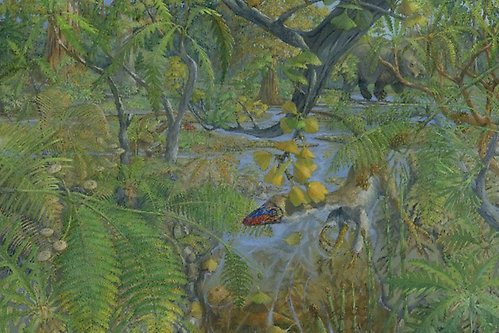Head of department and researcher
– I work with the strategic decisions regarding the exciting research that is conducted in the department. Equally important are the strategic decisions regarding our invaluable collections – the result of 200 years of collecting both animal and plant fossils. Creating a positive working environment for the staff and ensuring that we work together towards the museum's common goals is also one of my main responsibilities.
What is your research about in general?
- As a palaeontologist, I research questions related to the development of life on our earth, using fossils as the main tool. I am interested in solving questions related to the effects on ecosystems and individual species in connection with mass extinctions. Understanding ecology, geology and climate changes millions of years back in time can improve our prediction of the processes and patterns that will apply in relation to future clomate chianges.
My main tools are fossil spores and pollen from plants because these are abundantly preserved and quickly reflect changes in the environment and climate in the geological record. In the event of a global disaster, both plants and animals suffer extinction, and this is what I can track through the rock succession with the help of microfossils. Together with my research team, I have been working on clarifying the consequences for life on Earth as a result of the asteroid that struck in present-day Mexico 66 million years ago and wiped out 75% of the species on Earth, including the dinosaurs. The goal is to use the results of this extinction as a kind of template, in the detective work of investigating other disasters in the history of the Earth.
Tell us about your current research, or other relevant tasks at the museum.
- In the PlantEra project, with support from the Knut and Alice Wallenberg Foundation, we compare differences down to the cellular level between the plant groups that survived extensive environmental changes and those that died out in connection with prehistoric extinctions. We start from fossil plants and combine with studies on modern plants that we expose to different atmospheric levels of greenhouse gases. We hope to find out how plants have adapted to environmental changes and what physical functions govern resilience and survival.
An interesting and important objective for we researchers is to preserve the biological diversity on our planet. I work together with colleagues at the museum, and in Madagascar on projects related to the geological history of Madagascar and the development of its unique vegetation. The goal is to increase knowledge about the importance of preserving these unique ecosystems.
I also work with research-related issues within the Royal Academy of Sciences, where I am an elected member, and within the Royal Physiographic Society in Lund.
What do you find most interesting about your profession?
- To develop my department and to, in collaboration with my colleagues, add value to our collections and combine different sciences where we reach out to our audience together.
How did it come about that you started working at the Swedish Museum of Natural History?
- The museum is a unique workplace that combines exciting exhibitions and collections with science. In addition, the museum is a fantastic platform for conveying new discoveries through interactions with visitors from near and far, both on site and digitally.
Contact details

Vivi Vajda
Head of Department
Paleontology
vivi.vajda@nrm.se


